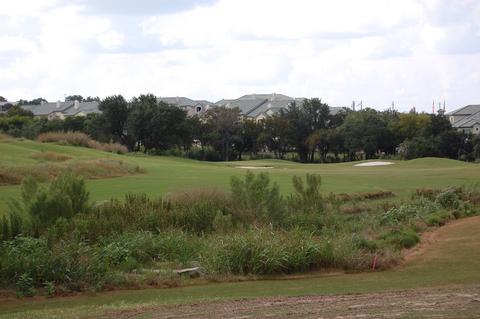Sorry, yesterday was the first day I haven't posted something in months. I was traveling to Austin, Texas. I will be in Austin this week, with planned visits to some of the area's best communities and one round a day. I am also dedicating myself to finding the best barbecue brisket in greater Austin, not an easy task I come to find. After a round of golf today at Falconhead in the Lake Travis area to the west of the city, I asked in the pro shop where I should stop for takeout barbecue on my 40-minute drive back to my hotel.
A riot almost broke out. The young lady at the snack bar suggested Rudy's. The assistant manager advised me to stop at Smoky Moe's. The golf pro said, no, he much prefers the 'cue at County Line Barbecue. I went with the first suggestion, Rudy's, which I had read some good reviews about, and I stopped there, and ordered a half pound of "moist" brisket (you can also have it "extra lean") and a half pound of baby back ribs, plus a few side orders.
The brisket was outstanding, easily cut with a fork, smoky and tasty. The ribs were another thing, tough and overly salty. Those poor ribs had spent way too long sunning themselves in a tanning booth. I think I will stick to brisket the rest of the week. The sides of cole slaw and creamed corn were excellent, the slaw leaning a llittle more toward mayonnaise than vinegar, and the creamed corn the real thing, fresh corn and what tasted like a homemade (and very fattening) cream sauce. On my rating scale of 1 to 5 pigs, I give Rudy's a 4 for the brisket, a 1 for the ribs and a 4 for the sides. Their barbecue sauce, which you serve yourself, had a nice peppery bite to it and did not taste commercial at all (even though they are happy to sell you bottles of the stuff).
Oh, the golf. I liked Falconhead, which offers some rolling fairways, open fairways interrupted by a few indigenous trees, and nice elevation changes. I made a mistake by playing the blue tees at 6,300 yards. Some of the holes were a little dinky from there; the tees at 6,800 would have afforded a much better challenge. For the first time, I used a Taylor Made R5 driver today with a regular shaft, hoping it would force me to swing more easily and forgive some badly pushed drives. It worked well; indeed one par 4 on the course played to just 258, and I was pin high and just off the green. I left the chip 10" short, my only birdie of the day.
More on Austin and its golf courses in the coming days.

The 16th at Falconhead is a short and reachable par 4 at 258 from the middle tees.























